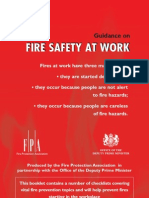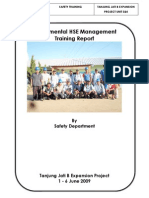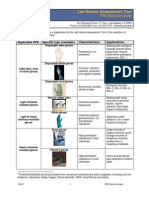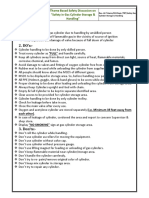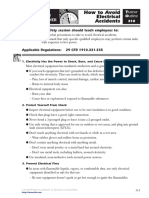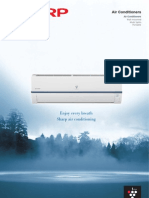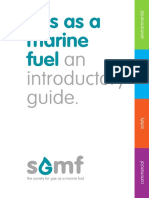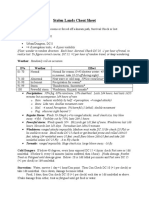Snowfall
Snowfall
Uploaded by
api-254403492Copyright:
Available Formats
Snowfall
Snowfall
Uploaded by
api-254403492Original Title
Copyright
Available Formats
Share this document
Did you find this document useful?
Is this content inappropriate?
Copyright:
Available Formats
Snowfall
Snowfall
Uploaded by
api-254403492Copyright:
Available Formats
Snowfall: The avalanche at tunnel creek
Introduction:
The New York Times astonishing Snow Fall: The Avalanche at Tunnel Creek, launched
in the final days of 2012, capped a year of extraordinary work in interactive journalism,
both at the Times and in newsrooms around the world. In the six days after Snow Falls
launch on December 20th, 2012, it had received more than 3.5 million page views and
2.9 million visitors, nearly a third of whom were new visitors to the Times website. Its
an exemplary piece of multimedia journalism, and its many moving (and swooping and
clicking) pieces have attracted intense attention from media commentators, but Snow Fall
began life not as a demonstration of technology and design capabilities, but with a
traditional, in-depth piece by Times reporter John Branch. Every accident can be traced
back to human error (Hess, 2012). This is especially true for outdoor pursuits. Even in
instances where an act of nature occurred, the source of error can likely be traced back
to a human decision (Hess, 2012). By thoroughly documenting, analyzing and learning
from accidents, the dangers of future wilderness pursuits can be greatly mitigated. In
2011 alone, there were 156 mountaineering accidents recorded in the United States
(Williamson, 2012). Careful analysis of each of these accidents holds the potential to
save lives. In recent decades, easy access to the winter backcountry is unprecedented.
Machines, such as helicopters and snowmobiles, allow us to travel quickly across terrain,
high into the mountains. These new technologies allow us to more efficiently climb and
ski formerly arduous mountains with minimal effort. Advertisements tell skiers and
snowboarders to seek fresh tracks outside the boundaries of the ski area. Avalanche
education courses are regularly offered throughout the winter months and increasingly
safety equipment gives users a false sense of security. The sport of skiing has reached a
level where professionals are going farther, faster, and bigger (Hansen, 2012) leaving
little margin for error. All too commonly experts fall victim to their own error. On
February 19th, 2012 a group of sixteen skiers and snowboarders left the boundary gates
of Stevens Pass Ski Area and headed for a ski run called Tunnel Creek. That day three
expert skiers were killed in an avalanche: Jim Jack, Chris Rudolph, and Johnny Brenan.
Their deaths attracted extensive publicity to the incident and tragically impacted the ski
community. When honoring the lives of these three men, it is important to analyze the
circumstances that ultimately cost them their lives, in hope to prevent this from
happening to other people. In their defense, these individuals were neither reckless nor
negligent in their actions that day and the situation they ended up in happens commonly.
Having personally been in similar circumstances while backcountry skiing, in which
family and friends are risking their lives, I can recognize a few simple decisions can
increase risk exponentially. Goal setting has been proven to increase the amount of effort
an individual will put in to reach a goal (Early, Connoly, & Ekegren, 1989). In many
situations, goals help the individual strive for higher levels of achievement and self-
betterment. However, there comes a point when goal setting no longer is productive,
when its narrow a goal can limit learning (Kayes, 2006). In a dynamic environment this
combination of effort and limitation can prove fatal. Similar patterns of goal setting
played a role in the events leading up to the Tunnel Creek avalanche of 2012.
Description:
The integration of multimedia in Snow Fall was purposeful. As New York Times
Graphics Director Steve Duenes explained in an interview with Poynter Online, they
were looking to find ways to create a seamless experience, So it didnt feel like you
were taking a detour, but the multimedia was part of the one narrative flow.
Beyond the multimedia integration, there were various technical and design components
brought into play:
There are silent videos that automatically play; some of them providing a
graphical backdrop, others as informative graphics.
There is a scrolling mechanism (called jquery.inview) which will trigger actions
as the user scrolls. For example, it will play a video, graphic animation or change
some CSS properties like fading the background.
A curtain effect that reveals or covers images and videos as the user scrolls.
While some of these are simple design embellishments, their power lies in the emotional
response they trigger as you venture through the story, and I use venture intentionally,
because this is the feeling that it evokes. Effective design triggers an emotional response
which can enhance the story structure.
Video Animations
From the opening video animation; which could have just been a static image; the viewer
is taken to a barren and ominous place. Using silent videos instead of still images is a
much more effective way of conveying this sense of place.
In Snow Fall, the opening animated images set the mood of the project in a similar style
to background music setting the mood of a movie. It creates an atmosphere from the very
moment the project opens. Its important that these videos are silent and repetitive. They
arent narratives; they arent meant to be watched or played in the same style as a stand-
alone video. Also, auto-playing audio on websites is considered poor design practice and
annoying to users.
Scrolling
This creates suspense going from photo to photo, unveiling more and more of the
narrative as the reader scrolls to explore this world. In more traditional journalism
environments, this might have been a slideshow, which I think would have completely
ruined the experience.
Scrolling also allows people to get a glimpse of what to expect from the package by
quickly going down the page and scanning the content. Web usability studies show that
users like to skim content, especially when presented with a large quantity of it. Weve
noticed that our journalism students similarly tend to scan through a piece before pausing
to read or watch it.
Curtain
Another mechanism used in the Snow Fall piece was the curtain effect, which creates the
sense of revealing or concealing panels of content as the user scrolls. The curtain effect
serves a few different purposes. Initially, its refers to as eye candy, a design
embellishment that wows the user, and draws them into the story. However, this effect is
ephemeral and will lose its impact as more and more people use it and it becomes more
commonplace. The curtain effect also makes the process of scrolling more playful and
adds a sense of mystery as the story unfolds as the curtain rises.
Analysis:
There are two incredible things about John Branchs multimedia feature in the New
York Times, Snow Fall: The Avalanche at Tunnel Creek. First, the story itself, as
in February, a group of skiing experts; the group consisted of a professional skier,
people who work in the skiing industry and people who run ski resorts, decided to
ski Tunnel Creek. Cowboy Mountain; part of the Cascade Range in Washington;
has a front and back side. The front is home to Stevens Pass, where there is a resort
and people looking for a winter getaway. The back is Tunnel Creek, where there is
nothing but trees and soft powder and daring souls whizzing down the slope. There
are continue at your own risk signs, as the Creek is unmonitored and, while not
private land, technically out of the resorts boundaries.
I suppose theres a safe way to ski Tunnel Creek; they say stay left at all costs
and dont plunge too far straight down, otherwise you will find yourself in a
terrain trap, essentially a valley that is littered with rocks and trees and acts as a
landing strip for avalanches. The slightest shift in snowpack can trigger one, and if
youre caught in the terrain trap, well, odds of survival are not good. Out of the
group Branch chronicles in his story, some chose the vertical route. What unfolded
was pure terror. Its an unbelievable story that Branch, an ace reporter and writer,
tells brilliantly.
The second incredible thing is the presentation of the story and what the Times
staff did with it. If youre curious what multimedia storytelling looks like at its
best, this is it: Compelling story, superb writing, beautiful graphics, stunning
design, 3-D interactive features that are simple to understand and awesome to look
at, video interviews embedded into the piece, audio, slideshows that add depth to
the characters and enrich your personal connection with this piece. Its hard to even
compare this piece to other written works, because we experience Snow Fall
through every medium possible. Words, images, sounds interactive features. We
get it all. The story is long, but even if you dont read it all, you should certainly
skim through just to see the design and enjoy the multimedia benefits.
The question is which the graphics and interactive features actually added to the
reading experience or not. In my opinion too often, cool-looking graphics become
clunky on the page with sub-optimal design, and although they still add some
element of experience, they detract from the work overall. They become a
distraction, they are frustrating, and they are barriers for reading on. Snow Fall
got that piece of this just right. As a reader, you get to a graphic and wanted to
engage it, because, in a simple manner, it helps you understand and visualize
events that are unfolding in the text, and then the graphic seamlessly pushes you
back out on the other side, back into the text. You never feel like you really left the
story. The text and graphics worked in harmony. It seems like the beginning of a
winning strategy would include providing spectacular digital content that can
overcome the limitations of paper and ink and be teased with a news story in the
print product.
Conclusion
All of these components together create a more immersive experience for the
viewer, like that found in traditional media like documentaries or long-form
narratives. In a digital world, creating this experience needs to include design
conventions and leveraging new technological innovations to engage readers. All
of this is experimental, but my hope is journalists will analyze and build on
projects like Snow Fall so we can more effectively deliver news and other content
to the public.
References:
Branch, J. (2012, December 26). Snow fall: The avalanche at tunnel creek.
Retrieved from http://www.nytimes.com/projects/2012/snow-fall/
Brown, R. (2000). Group Processes (2nd ed.). Oxford: Blackwell.
Kayes, D. C. (2006). Destructive goal pursuit: The mount everest disaster. New
York, NY: Palgrave Macmillan.
La Chapelle, E. (2001). Secrets of the snow: Visual clues to avalanche and ski
conditions. Seattle, WA: University of Washington Press.
McClung, D., & Schaerer, P. (2006). Books. The avalanche handbook. Seattle,
WA: The Mountaineers Books.
Michelson, M. (2012, November 14). Tunnel vision. Retrieved from
http://www.outsideonline.com/outdoor-adventure/snow-sports/Tunnel-Vision-
November-2012.html?page=all
Janis, I.L. (1972). Groupthink: Psychological studies of policy decisions and
fiascoes, 2nd ed., Boston, MA: Houghton Mifflin.
Hansen, M. (2012). Natures Feedback: Why are so many of the best skiers
dying? Powder Magazine, 41(4): 111-30.
Hess, R. (2012). Know the ropes: Rappelling. In J. E. Williamson (Ed.),
Aamerican mountaineering: 2012 Accidents in north american mountaineering
(2nd ed., Vol. 10). Golden, CO: The American Alpine Club.
Williamson, J. E. (2012)., Accidents in North American Mountaineering. 2nd ed.,
Golden, CO: The American Alpine Club
Jamieson, B., Haegeli, P., & Gauthier, D. (2010).Avalanche accidents in canada:
1996-2007. (Vol. 5). Revelstoke, BC: Canadian Avalanche Association.
Gaffney, R. (2013). Sportgevity. Retrieved from
http://sportgevity.com/article/gettin-ready-first-edition
Napa Valley Register. (2012, February 23). Christopher rudolph. Retrieved from
http://napavalleyregister.com/news/local/obituaries/christopher-
rudolph/article_284cc466-5dde-11e1-8f1f-0019bb2963f4.html
Carlsen, K. (2012, April 02). Owens, J., Morrison, P., & Moore, M. (2012). Jim
Norman Jack: 1965-2012. Retrieved from
http://www.powdermag.com/stories/jim-norman-jack-1965-2012/
The Wenatchee World Staff. (2012, February 24). Johnny patrick brenan.
Retrieved from http://www.powdermag.com/stories/jim-norman-jack-1965-2012/
Early, P.C, Connolly, T., and Ekegren, G. (1989). Goals, strategy development,
and task performance: Some limits on the efficacy of goal-setting. Journal of
Applied Psychology, 74(1), 24-33.
Diana L. Di Stefano,"Disasters,RailwayWorkersa,nd theLaw
inAvalancheCountry1,880- 1910,"EnvironmentHalistory14 (July2009):476-501.
Colorado Avalanche Information Center. (2012) Avalanche accident statistics.
Retrieved from https://avalanche.state.co.us/acc/acc_stats.php
Opp, A., & Moore, M. (2012). Alpental ski area backcountry: Wac bluffs
accident. Northwest Weather and Avalanche Center.
Owens, J., Morrison, P., And Moore, M. (2012). Tunnel Creek Avalanche
Incident. Northwest Weather and Avalanche Information Center.
Morrison, P., Moore, M., & , (2011). Tunnel creek avalanche accident. Northwest
Weather and Avalanche Center.
Martin, Z., Baker, P., & , (2012). Union creek avalanche accident. Northwest
Weather and Avalanche Center.
McCammon, I. (2004). Heuristic traps in recreational avalanche accidents:
Evidence and implications. Avalanche News, 68.
Moore, M. (2013). Northwest avalanche accident summaries: 1983-2013.
Northwest Weather and Avalanche Center.
- See more at: http://sportgevity.com/article/goal-setting-and-risk-
perception-accident-analysis-tunnel-creek-
avalanche#sthash.KWdzXDSf.dpuf
You might also like
- Suasive Iterations: Rhetoric, Writing, and Physical ComputingFrom EverandSuasive Iterations: Rhetoric, Writing, and Physical ComputingNo ratings yet
- Work Method Statement: SWMS Form 007.3Document3 pagesWork Method Statement: SWMS Form 007.3George VNo ratings yet
- Lifting and Carrying MaterialsDocument2 pagesLifting and Carrying MaterialsZeeshan BajwaNo ratings yet
- Basic Safety Powerpoint NCCERDocument115 pagesBasic Safety Powerpoint NCCERGeean100% (1)
- Incheon International Airport PresentationDocument26 pagesIncheon International Airport PresentationOyelakin Gbolahan PearlNo ratings yet
- Lifting & Rigging ProceduresDocument32 pagesLifting & Rigging ProceduresBrunoro DantasNo ratings yet
- MPU34132 SPORTS: Sport Injuries, Treatment and PreventionDocument31 pagesMPU34132 SPORTS: Sport Injuries, Treatment and PreventionR TinishahNo ratings yet
- Workplace Inspection Checklist: General Yes No NotesDocument4 pagesWorkplace Inspection Checklist: General Yes No NotesInigoNo ratings yet
- Portable Equp MNT GuideDocument0 pagesPortable Equp MNT GuideashawishNo ratings yet
- Risk Matrices Implied Accuracy and False Assumptions PDFDocument8 pagesRisk Matrices Implied Accuracy and False Assumptions PDFAnonymous FmXEu2cHxKNo ratings yet
- Electrical Testing and SafetyDocument6 pagesElectrical Testing and SafetyboypardedeNo ratings yet
- JEE (Main) & JEE (Advanced) - 2015Document30 pagesJEE (Main) & JEE (Advanced) - 2015Santosh Kumar67% (3)
- Fire ExtinguisherDocument20 pagesFire ExtinguisherFaisel RaheemNo ratings yet
- Electrical Security and Safety HandbookDocument10 pagesElectrical Security and Safety HandbookRYAN S. BUDIONGANNo ratings yet
- Att Job Safety Assessment (Jsa) Rev F Dated 9-22-15Document2 pagesAtt Job Safety Assessment (Jsa) Rev F Dated 9-22-15Brandon Moore0% (1)
- COVID 19 Protocols Version 2 - 20 April 2020 PDFDocument8 pagesCOVID 19 Protocols Version 2 - 20 April 2020 PDFMark Ronald SuaisoNo ratings yet
- Trench SafetyDocument2 pagesTrench SafetyZeeshan BajwaNo ratings yet
- AP Work Height SWPDocument30 pagesAP Work Height SWPfuazNo ratings yet
- Safe Systems of Work 2Document23 pagesSafe Systems of Work 2Hossam AbdelmoneimNo ratings yet
- Biomechanics of Work: Yansen Theopilus, S.T., M.TDocument68 pagesBiomechanics of Work: Yansen Theopilus, S.T., M.TuytyuytryuNo ratings yet
- 10EE761 - Unit 1 Intro To PSPDocument37 pages10EE761 - Unit 1 Intro To PSPsrinimeha@gmail.comNo ratings yet
- Emergency ProtocolsDocument5 pagesEmergency Protocolsapi-360747004No ratings yet
- Monthly Safety Campaign - June 2020Document1 pageMonthly Safety Campaign - June 2020IETqatarNo ratings yet
- Confined Space Entry - CCOHS-1Document12 pagesConfined Space Entry - CCOHS-1Mohamed hadjadj100% (1)
- Emergency Warden Training For ADDocument20 pagesEmergency Warden Training For ADsetiawanaji407No ratings yet
- Arkansas Kraft Division Contractor Safety OrientationDocument63 pagesArkansas Kraft Division Contractor Safety Orientationdavid_stephens_29No ratings yet
- 5a Hazard ManagementDocument45 pages5a Hazard ManagementChoa Pei ShuangNo ratings yet
- Medication Safety LP FF CrosswordDocument3 pagesMedication Safety LP FF Crosswordgreisann100% (1)
- Egress & Fire Protection L&I v1Document29 pagesEgress & Fire Protection L&I v1Areiffz IsmailNo ratings yet
- Basic Fire Fighting Training1Document56 pagesBasic Fire Fighting Training1Kh MoNo ratings yet
- Fes Hazad FallDocument3 pagesFes Hazad FallSayed AbbasNo ratings yet
- Employee Welfare Program Feb - 2010Document12 pagesEmployee Welfare Program Feb - 2010Javaid SalimNo ratings yet
- Fire Safety at WorkDocument8 pagesFire Safety at Workapi-26802090100% (1)
- Environmental Engineer Health Safety in Little Rock AR Resume Sandra WilksDocument3 pagesEnvironmental Engineer Health Safety in Little Rock AR Resume Sandra WilksSandraWilksNo ratings yet
- Is 4573 1982Document45 pagesIs 4573 1982pankaj100% (1)
- Fundamental HSE Management TrainingDocument8 pagesFundamental HSE Management TrainingIGede SumantraNo ratings yet
- Lab Hazard Assessment Tool: Applicable PPE Specific Type (Example) Characteristics ApplicationsDocument4 pagesLab Hazard Assessment Tool: Applicable PPE Specific Type (Example) Characteristics ApplicationsXozanNo ratings yet
- Unsafe Acts and Unsafe ConditionsDocument31 pagesUnsafe Acts and Unsafe ConditionsAI KoNo ratings yet
- IOSH MS (Transco) Project - Adil GibreelDocument10 pagesIOSH MS (Transco) Project - Adil Gibreelad_gibNo ratings yet
- 0 - Office Health and SafetyDocument77 pages0 - Office Health and SafetyelickNo ratings yet
- Flemble SubtstancesDocument12 pagesFlemble SubtstancesWahed Mn ElnasNo ratings yet
- B13058Document21 pagesB13058Syed Ahmedullah HashmiNo ratings yet
- Theme Based Safety Discussion - Gas Cylinder Storage & HandlingDocument2 pagesTheme Based Safety Discussion - Gas Cylinder Storage & HandlingMr. XNo ratings yet
- A Guide To Safe ScaffoldingDocument38 pagesA Guide To Safe ScaffoldingWinki CynthiaNo ratings yet
- 'Myths of Hazop Hazan' - An Article by Mr1 Abhay Gujar in 'Journal of Loss Prevention' UK - 1996Document5 pages'Myths of Hazop Hazan' - An Article by Mr1 Abhay Gujar in 'Journal of Loss Prevention' UK - 1996Himanshu N Annu YadavNo ratings yet
- A Safety Alert Maintenance 1 IADCDocument10 pagesA Safety Alert Maintenance 1 IADCVeeramuthu SundararajuNo ratings yet
- NR 12 - Lockout and TaggingDocument5 pagesNR 12 - Lockout and TaggingCPSSTNo ratings yet
- Lockout or Tag Out and Electrical SafetyDocument31 pagesLockout or Tag Out and Electrical SafetyMustafizur Rahman100% (1)
- Niversity of Eicester: P W P R E & F M DDocument27 pagesNiversity of Eicester: P W P R E & F M DFOZCANNo ratings yet
- WHMIS ChineseDocument48 pagesWHMIS ChineseSm KimNo ratings yet
- Work Accidents Investigation Technique WAIT-part IDocument18 pagesWork Accidents Investigation Technique WAIT-part IRajiv NavadiyaNo ratings yet
- 1658936909.7522428 - Gilley Enterprises Inc Workplace Violence and Prevention PolicyDocument7 pages1658936909.7522428 - Gilley Enterprises Inc Workplace Violence and Prevention PolicyJhems ElisNo ratings yet
- Safety Guidelines - GBDocument28 pagesSafety Guidelines - GBLalit TomarNo ratings yet
- ErpDocument31 pagesErpNurul Badriah Anwar AliNo ratings yet
- Training CalanderDocument2 pagesTraining CalanderCivil DiaryNo ratings yet
- Chasing Ice ThesisDocument5 pagesChasing Ice ThesisJeff Nelson100% (2)
- Instant Ebooks Textbook Disney Stories Getting To Digital Krystina Madej Download All ChaptersDocument36 pagesInstant Ebooks Textbook Disney Stories Getting To Digital Krystina Madej Download All Chapterssreykaelyad100% (6)
- Homework Using AurasmaDocument3 pagesHomework Using AurasmaWai LonnNo ratings yet
- Essay About Internet Advantages and DisadvantagesDocument6 pagesEssay About Internet Advantages and Disadvantagesafibaixzyhpqmc100% (2)
- Research Methods For The Behavioral Sciences 6th Edition Gravetter Solutions ManualDocument39 pagesResearch Methods For The Behavioral Sciences 6th Edition Gravetter Solutions Manualweickumralphie100% (19)
- English TensesDocument4 pagesEnglish TensesNassim DjellaliNo ratings yet
- Reading - 5 FINALDocument3 pagesReading - 5 FINALIlhamNo ratings yet
- Camera ControlsDocument8 pagesCamera ControlsJerryMumbaiNo ratings yet
- Temperature Fever ConvulsionsDocument3 pagesTemperature Fever Convulsionscheryl napierNo ratings yet
- AirCon Multi Splits BroDocument12 pagesAirCon Multi Splits BroDevendra HajareNo ratings yet
- SGMF - Gas As A Marine Fuel - An Introductory GuideDocument50 pagesSGMF - Gas As A Marine Fuel - An Introductory Guide이동건100% (1)
- XI mathematics projectDocument21 pagesXI mathematics projectrkpalacharla84No ratings yet
- 15-16 Lab Manual PDFDocument185 pages15-16 Lab Manual PDFSeven VirtuesNo ratings yet
- Mini Repertory VitalforceDocument14 pagesMini Repertory VitalforceBabli Lovely Nicky100% (2)
- ParkerDocument282 pagesParkerAdrian PetrascuNo ratings yet
- Stolen Lands Cheat SheetDocument4 pagesStolen Lands Cheat SheetToucanBuzzNo ratings yet
- 3 MewsDocument146 pages3 Mewsdiana100% (1)
- Things To Carry List For WintersDocument6 pagesThings To Carry List For WintersAbhra DasNo ratings yet
- Tutorial PHOPTOSHOPDocument3 pagesTutorial PHOPTOSHOPkerem11No ratings yet
- Bộ Đề Kiểm Tra Hkii Anh 6 GsDocument46 pagesBộ Đề Kiểm Tra Hkii Anh 6 GsPhương HuỳnhNo ratings yet
- The Kalevala: The Land of The Heroes (Tr. by WM Forsell Kirby), Part 1Document352 pagesThe Kalevala: The Land of The Heroes (Tr. by WM Forsell Kirby), Part 1Turquoise Tortoise100% (1)
- Class 7 2017 Paper 1.compressed PDFDocument25 pagesClass 7 2017 Paper 1.compressed PDFTransformer100% (1)
- Civil-Net Zero Residential BuildingDocument83 pagesCivil-Net Zero Residential BuildingDhruv100% (1)
- 6.R.The Little Ice AgeDocument3 pages6.R.The Little Ice Agems.pannupyonehlaingNo ratings yet
- 2000 IBC Handbook Seismic Wind PDFDocument9 pages2000 IBC Handbook Seismic Wind PDFAnonymous xC6bM4x6U6No ratings yet
- Forecasting: Statistics 2 ITESM Campus Guadalajara Prof: Ing. Maria Luisa OlascoagaDocument110 pagesForecasting: Statistics 2 ITESM Campus Guadalajara Prof: Ing. Maria Luisa Olascoagajacks ocNo ratings yet
- DILG Resources PDFDocument53 pagesDILG Resources PDFalexNo ratings yet
- Energizer BookDocument12 pagesEnergizer BookgmcrinaNo ratings yet
- Important Questions (Agriculture)Document9 pagesImportant Questions (Agriculture)Kunal HazarikaNo ratings yet
- Science Art Integration FinalDocument25 pagesScience Art Integration FinalresmiNo ratings yet
- Sa Regional Max Flood Peaks MethodDocument98 pagesSa Regional Max Flood Peaks MethodBoiki RabewuNo ratings yet
- Panasonic: Wide Operating Temperature RangeDocument1 pagePanasonic: Wide Operating Temperature RangeИван НоваковNo ratings yet
































